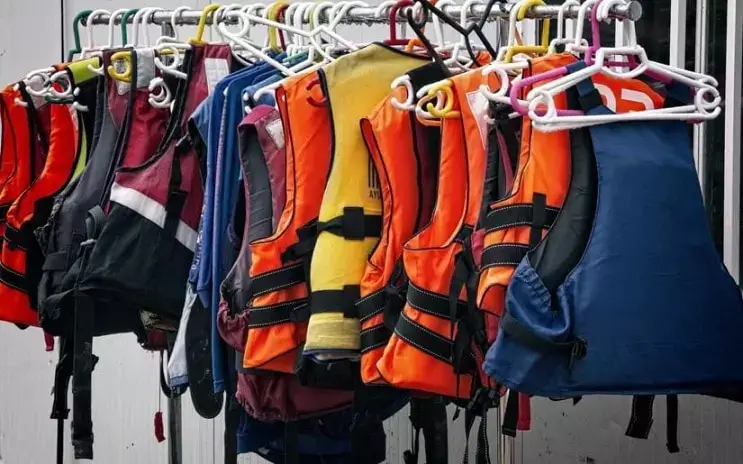Last Updated on August 14, 2023 By Emma W. Thomas
A Personal Flotation Device (PFD) degrades due to factors like sunlight exposure, water immersion, and wear. UV rays can weaken materials by up to 60% in 3 years. Constant water exposure, common in marine settings, can reduce buoyancy over time, compromising safety.
What Causes A PFD To Wear Out Over Time?
Over time, a Personal Flotation Device (PFD), such as a life jacket, can wear out, reducing its effectiveness when it’s needed most. Here are several factors that can lead to its degeneration:
- Exposure to Sunlight:
Prolonged exposure to sunlight can cause the fabric of a PFD to fade and weaken. UV light breaks down the chemical bonds in the material, making it more likely to tear or fray. - Harsh Chemicals:
Regular contact with harsh detergents, gasoline, or oil can deteriorate the foam or inflatable parts of a PFD over time. These substances can damage both the interior and exterior of the device. - Frequent Use:
Continual use will naturally cause wear and tear on any item, including PFDs. The foam inside the device may start to break down over time, losing its buoyancy and reducing its effectiveness. - Incorrect Storage:
If stored in a damp or high-temperature location, a PFD can be prone to mold and mildew growth. Moldy vests are not only unattractive but may also pose a health risk. - General Aging:
All materials degrade over time. This is also true for buoyant materials used in PFDs. Older PFDs may not hold up as well under pressure as newer models and may fail when needed. - Abrasion:
Abrasion from hard or sharp objects can weaken the fabric over time, diminishing the strength and tear resistance of your PFD.
| Causes of PFD Deterioration | Effects |
|---|---|
| Exposure to Sunlight | Weakening of fabric |
| Harsh Chemicals | Damage to foam or inflatable parts |
| Frequent Use | Breakdown of foam, reduced buoyancy |
| Incorrect Storage | Mold and mildew growth |
| General Aging | Reduced strength and effectiveness |
| Abrasion | Decreased tear resistance |
Thus, it’s vital to regularly inspect your Personal Flotation Device for signs of wear and tear, clean it properly after each use, and store it in a cool, dry place away from sunlight. Replace it when necessary to ensure your safety on the water.
Caring For Your PFDs

Taking care of your PFDs helps them last longer and ensures your safety and that of your passengers on the water if you are a boat owner. Here’s what to do;
1. Checking Your PFDS Before Use
Before going out on your boat, make sure that you test your floatation devices. Ensure that the tools are safe to use and that they will float. If you have an inflatable PFD, make sure that it does not have any air leaks before embarking on a boating trip. Check for mold or mildew in the synthetic fiber before using it in the water.
For your inflatable PFD, check the inflator’s status and ensure that the CO2 cylinder is full, it does not leak, and it is also tightly screwed in. You can also check for leaks in the device by inflating it after removing the cylinder. The Floating jacket should remain firm for several hours.
Test your device’s buoyancy in shallow water or a swimming pool. Inspect the jackets frequently for tears or rips, weak or discolored fiber, insecure zippers or straps, as well as illegible labels. If any PFD has a problem, discard and replace it.
Follow the manufacturer’s instructions guide to give your device regular maintenance.
2. Proper Storage
Proper storage of your PFDs will help to prolong their life. Make sure that the life jackets are dry before storing them in a cool, dry location. You also need to keep them away from direct sunlight. You can keep the devices either in boxes on your boat or in your garage if you use them for recreational activities such as kayaking.
3. Do Not Tamper With Your PFD
Avoid altering your floatation device as this will affect its integrity and make it non-compliant to Coat Guard regulations. Do not tamper with the PFD if it does not fit your passenger but instead consider buying a new one.
4. Cleaning
Cleaning your PDF after every use is also vital to keep it in good condition and working. Use soapy, clean water, and a soft surface brush to remove the dirt. Drain the water after washing and dry with a clean towel before storing it. A well-cared-for device stays longer than one that is handled without any care.
How Often Should I Replace My PFD?
A PFD has no expiry date, and every care you give it helps to lengthen its use. But if you repair or alter this device, it becomes void and no longer usable. You should thus replace and discard your floatation device for recycling when it is not safe for use anymore.
Repairing or altering your PFD compromises its efficiency since no control method verifies the quality of repair or alteration.
If your PFD is weak or worn due to prolonged use, exposure, or improper storage, you need to replace it. If your shoulder strap material breaks down, it becomes hazardous to use the device.
Another reason why you need to replace your PFD is when it loses its buoyancy. If the floatation and foam break down for various reasons, it is time to buy a new one. Ensure that you check your item every year, but you should not use it for more than 5 years. A PFD’s buoyancy is rated at 15.5 lbs which is the average weight of a human head. Your PFD should support your head comfortably above the water with the chin exposed.
Benefits Of A Personal Floatation Device
A personal floatation device has various benefits, and every boat owner should have one for themselves and their passengers. Here’s why it is essential;
1. It Saves Lives
A PFD is not an all-time outfit but one that is designed for specific purposes. The gear is essential to keep you floating on water. It is mostly used by the marine rescue team, those learning how to swim, and for other water activities like kayaking.
According to statistics, most deaths from drowning are a result of a lack of PFDs. It is, therefore, vital to have a PFD when sojourning on the water.
2. Improves Your Swimming Training
A personal floatation device is an essential part of swimming training kits. Swimming is exciting and fun, but it is also risky if one does not know how to swim. One can quickly lose a life by jumping into a pool without a floatation device when you are a beginner swimmer.
Make sure you have a PFD if you want to learn how to swim safely. You can either purchase one or acquire one from the swimming center. This item enables you to move around the pool and even in the deepest part as it lets you float and protect you from drowning.

Conclusion
A personal flotation device helps to save a life when used on water. Ensure that you handle it with care for it to last longer and to prevent wearing out. Always keep it away from direct sunshine as exposure to ultraviolet radiation spoils the fiber. Clean and adequately dry before storing the tool to prevent molding and mildew.
References:
https://www.boat-ed.com/indiana/studyGuide/Maintain-PFDs-in-Good-Condition/10101602_35411/
https://otterbeeoutdoors.com/what-causes-a-pfd-to-wear-out-over-time/
Emma is a graduate of Domestic Science or Family and Consumer Sciences (Home Economics) from the University of Wisconsin. She has 7 years of experience Working with the strategic section of BestBuy and now writing full-time for Homeeon.
From Managing the Home, Interiors, Cleaning, and Exteriors to Gardening and everything about Making A Home Liveable – is her passion and this Homeeon is the result of this.
Emma loves decorating her home with the best stuff found online. She cares about quality over anything and writes reviews about them here in Homeeon. Get in touch with her over Pinterest.
Keep reading her blogs.

